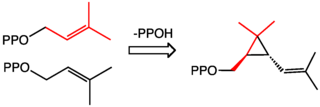User:Egilmore15/sandbox
 | This is a user sandbox of Egilmore15. A user sandbox is a subpage of the user's user page. It serves as a testing spot and page development space for the user and is not an encyclopedia article. |
Pyrethrin Article Outline
[edit]The pyrethrins are a pair of natural organic compounds normally derived from Chrysanthemum cinerariifolium that have potent insecticidal activity, attacking the nervous systems of insects. Pyrethrins are gradually replacing organophosphates and organochlorides as the pesticide of choice, since organochlorides have been shown to have significant and persistent toxic effects to humans. Because they are biodegradable compounds, pyrethrins are being phased out in favor of pyrethroids, a group of synthetic analogues of pyrethrin, for insecticide uses, and appear to have an insect repellent effect when present in non-fatal doses.
History
[edit]The pyrethrins occur in the seed cases of the perennial plant pyrethrum (Chrysanthemum cinerariaefolium), which has long been grown commercially to supply the insecticide. Pyrethrins have been used as an insecticide for thousands of years. It is believed that the Chinese crushed Chrysanthemum plants and used the powder as an insecticide as early as 1000 BCE. Pyrethrins were identified as the potent chemical in the Chrysanthemum plants responsible for the insecticide properties in the crushed flowers around 1800 in Asia. Since then, the plant has been commercialized to it's wide usage now.[1]
Well after their use as insecticides, their chemical structures were determined by Hermann Staudinger and Lavoslav Ružička in 1924.[2]Pyrethrin I and pyrethrin II are structurally related esters with a cyclopropane core. Pyrethrin I is a derivative of (+)-trans-chrysanthemic acid.[3][4] Pyrethrin II is closely related, but one methyl group is oxidized to a carboxymethyl group, the resulting core being called pyrethric acid. Knowledge of their structures opened the way for the production of synthetic analogues, which are called pyrethroids. In terms of their biosynthesis, pyrethrins are classified as terpenoids, being derived from dimethylallyl pyrophosphate, which combine by the action of the enzyme chrysanthemyl diphosphate synthase.[5]
Production
[edit]elaborate on process of production
History
[edit]Legal History
[edit]Use as an Insecticide
[edit]Toxicity
[edit]Chronic Toxicity
[edit]Environmental Effects
[edit]- related to cut flower industry in Kenya, environmental and social issues
More Recent Studies
[edit]Bibliography
[edit]Potential References:
Pyrethrin and Pyrethroid Exposures in the United States:A Longitudinal Analysis of Incidents Reported to Poison Centers http://www.ncbi.nlm.nih.gov/pmc/articles/PMC3550062/pdf/13181_2009_Article_BF03160917.pdf
Characteristics and Magnitude of Acute Pesticide-Related Illnesses and Injuries Associated With Pyrethrin and Pyrethroid Exposures—11 States, 2000–2008
Pyrethroid toxicity and its management http://www.bpac.org.nz/BPJ/2013/December/docs/BPJ57-pyrethroid.pdf
Poisoning due to Pyrethroids http://www.ncbi.nlm.nih.gov/pubmed/16180929
http://www.cdpr.ca.gov/docs/emon/pubs/fatememo/pyrethrin_efate2.pdf
National Pesticide Information Center : http://npic.orst.edu/factsheets/pyrethrins.pdf
Extonet : http://pmep.cce.cornell.edu/profiles/extoxnet/pyrethrins-ziram/pyrethrins-ext.html
Is Cumulated Pyrethroid Exposure Associated With Prediabetes? A Cross-sectional Study - http://www.ncbi.nlm.nih.gov/pmc/articles/PMC4205931/
High levels of resistance to carbamate and pyrethroid chemicals widespread in Australian Myzus persicae (Hemiptera: Aphididae) populations. - http://www.ncbi.nlm.nih.gov/pubmed/25195456
Application of spinosad increases the susceptibility of insecticide-resistant Alphitobius diaperinus (Coleoptera: Tenebrionidae) to pyrethroids. - (spinosad is another neural disruptor insecticide) http://www.ncbi.nlm.nih.gov/pubmed/25195452
EPA's SHEDS-multimedia model: Children's cumulative pyrethroid exposure estimates and evaluation against NHANES biomarker data http://www.sciencedirect.com/science/article/pii/S0160412014002566
http://npic.orst.edu/factsheets/pyrethrinrefs.html
“Environmental Fate of Pyrethrin” http://www.cdpr.ca.gov/docs/emon/pubs/fatememo/pyrethrin_efate2.pdf
“Characteristics and magnitude of acute pesticide-related illnesses and injuries associated with pyrethrin and pyrethroid exposures-11 states” http://onlinelibrary.wiley.com/doi/10.1002/ajim.22216/full
“Pyrethrins: Fourth Report of the Cancer Assessment Review Committee”
“Mode-of-action analysis for induction of rat liver tumors by pyrethrins: relevance to human cancer risk” http://informahealthcare.com/doi/abs/10.1080/10408440902914014
“Toxicity of natural and synthetic pyrethrins to rats” http://www.sciencedirect.com/science/article/pii/004835757290034X
“Pyrethrin II and related esters obtained by reconstitution” https://books.google.com/books?hl=en&lr=&id=vz2-kF6NKeIC&oi=fnd&pg=PA25&dq=“Pyrethrin+II+and+related+esters+obtained+by+reconstitution”&ots=DdpfAb7rhh&sig=sJIW2PMDFe0_HXZClbXyijoYdwc#v=onepage&q=“Pyrethrin%20II%20and%20related%20esters%20obtained%20by%20reconstitution”&f=false
“Oxidative metabolism of pyrethrins in mammals” http://www.nature.com/nature/journal/v230/n5292/abs/230326a0.html
“Recognition and Management of Pesticide Poisonings” http://www.epa.gov/oppfead1/safety/healthcare/handbook/handbook.htm
“Handbook of Pesticide Toxicology” Ujvar, I. Pest Control Agents from Natural Products. Handbook of Pesticide Toxicology, 3rd ed.; Krieger, R. I., Ed.; Academic Press, Inc.: San Diego, 2010; Vol. 1, pp 120-127
“Pyrethrin General Fact Sheet” http://npic.orst.edu/factsheets/pyrethrins.pdf
http://onlinelibrary.wiley.com/doi/10.1002/ajim.22216/full
http://www.sciencedirect.com/science/article/pii/S1090023308001573 - Use and abuse of pyrethrins and synthetic pyrethroids in veterinary medicine
http://www.neuropetvet.com/intracranial-dz/pyrethrin-toxicity/ - neuro pet vet
http://toxsci.oxfordjournals.org/content/130/2/309 - Environmentally Relevant Mixtures in Cumulative Assessments: An Acute Study of Toxicokinetics and Effects on Motor Activity in Rats Exposed to a Mixture of Pyrethroids
http://www.ncbi.nlm.nih.gov/pmc/articles/PMC1570056/ - A Longitudinal Approach to Assessing Urban and Suburban Children’s Exposure to Pyrethroid Pesticides
lists a lot of articles: http://bvsalud.org/portal/resource/en/mdl-16496491
http://www.ncbi.nlm.nih.gov/pmc/articles/PMC3550062/pdf/13181_2009_Article_BF03160917.pdf - Pyrethrin and Pyrethroid Exposures in the United States: A Longitudinal Analysis of Incidents Reported to Poison Centers
http://www.publichealthreports.org/issueopen.cfm?articleID=2163 - Pyrethrin and Pyrethroid Illnesses in the Pacific Northwest: A Five-Year Review
http://webcache.googleusercontent.com/search?q=cache:g24UxbThTIgJ:cfpub.epa.gov/si/si_public_file_download.cfm%3Fp_download_id%3D519477+&cd=10&hl=en&ct=clnk&gl=us - title is Environmentally Relevant Mixing Ratios in Cumulative Assessments: A Study of theKinetics of Pyrethroids and Their Ester Cleavage Metabolites in Blood and Brain; and theEffect of a Pyrethroid Mixture on the Motor Activity of Rats
other titles that we can look at / request from library: Pyrethroid exposure of the general population is this due to diet, Reference values for metabolites of pyrethroid and organophosphorous insecticides in urine for human biomonitoring in environmental medicine, Pyrethroid insecticides advances and challenges in biomonitoring,
- ^ Gunasekara, Amrith S. "Environmental Fate of Pyrethrins." Environmental Monitoring Branch, Department of Pesticide Regulation (2004): 3-5. Print.
- ^ Staudinger, H. und Ruzicka, L. (1924). "Über die wirksamen Bestandteile des dalmatinischen Insektenpulvers". Helv chim acta. 7: 177. doi:10.1002/hlca.19240070124.
{{cite journal}}: CS1 maint: multiple names: authors list (link) - ^ Merck Index, Eleventh Edition, 7978.
- ^ McGraw-Hill Ryerson Chemistry 12 p.99 Michael Townsend
- ^ Rivera, Susan B.; Swedlund, Bradley D.; King, Gretchen J.; Bell, Russell N.; Charles, E. Hussey Jr.; Shattuck-Eidens, Donna M.; Wrobel, Wislawa M.; Peiser, Galen D.; Poulter, C. Dale (2001). "Chrysanthemyl diphosphate synthase: Isolation of the gene and characterization of the recombinant non-head-to-tail monoterpene synthase from Chrysanthemum cinerariaefolium". Proceedings of the National Academy of Sciences. 98: 4373–4378. doi:10.1073/pnas.071543598.

